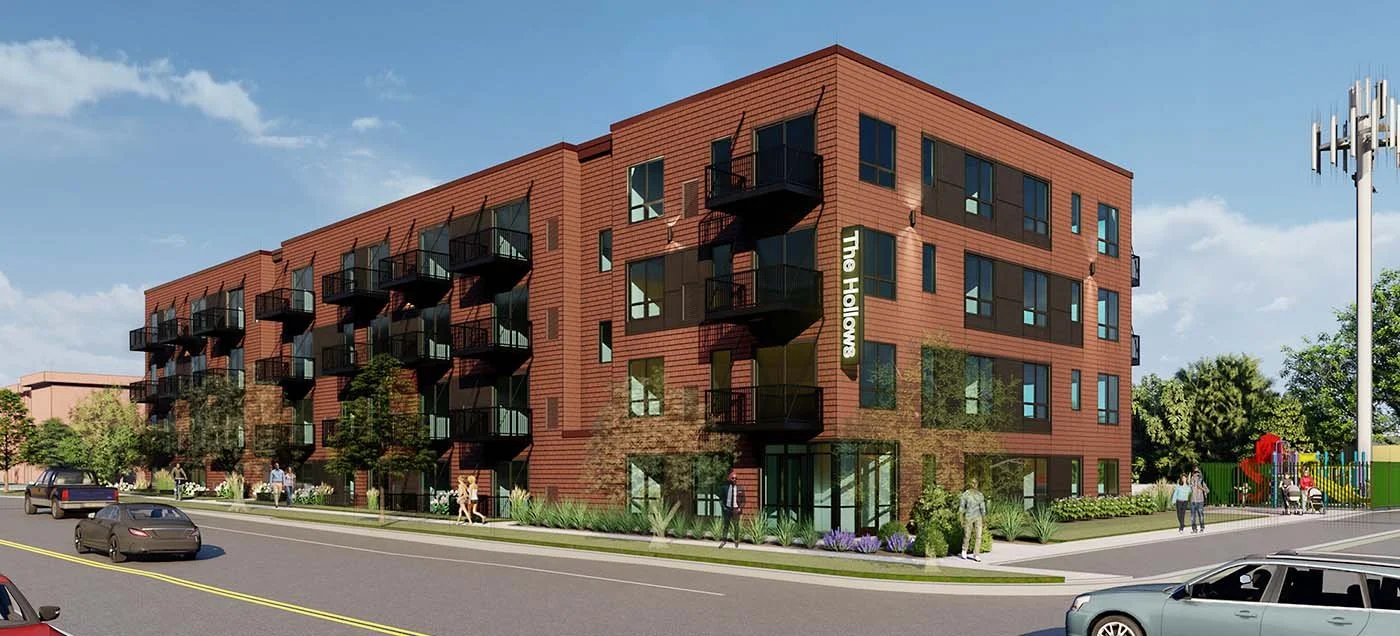After 4 years, first-time developer will launch 62-unit apartment building at Payne and East Seventh
[Originally Published On Twin Cities Pioneer Press, Written By Frederick Melo: View Source.]
Rendering of The Hollows, a 62-unit, $18.7 million affordable housing development at 520 Payne Ave. off East Seventh Street, just east of downtown. The JO Companies will be backed by more than $3 million in tax increment financing, a type of city subsidy, as well as conduit housing revenue bonds, low-income housing tax credits and state and county grants. All of the units will meet the technical definition of affordable housing, and 20 percent of the units will be priced for deeper affordability, including five $560 one-bedroom apartments targeted to households earning roughly $31,500.
In a prior life, Johnny Opara spent 17 years in business-to-business sales with Medtronic, CenturyLink, Cox Automotive and International Paper. The first-time developer may have just cleared his biggest sale yet — convincing the city of St. Paul to back a 62-unit, $18.7 million affordable-housing development just east of downtown.
For Opara, the president, founder and chief executive officer of the JO Cos., it’s been a long four years. The licensed Realtor sat down with St. Paul City Council member Jane Prince in 2017 to pick her brain about potential sites ripe for new housing. Prince suggested vacant, city-owned land off Payne Avenue and East Seventh Street, almost across the street from the Minnesota Music Cafe.
“I thought, wow, 520 Payne is such a phenomenal gateway location,” Prince said. “It is a gateway property to Payne Avenue, to the East Seventh Street business district. It is right down the hill from Metro State University.”
Opara, a Central High School and Augsburg University graduate who came to the U.S. from Nigeria as an infant and was raised on Rice Street in St. Paul, drove by the site the same day, and then called Prince to confirm he was hooked. “I always say St. Paul raised me,” said Opara, in an interview Thursday. “I visited the site and I saw the Hollows. I knew exactly what was going to be built.”
Challenging Years
What he didn’t know at the time was that easements, airport flight paths, cell towers, financing challenges, a recession and a pandemic would put years of potential stumbles in his path.
Those were overcome, in part, with the help of Prince and city council President Amy Brendmoen, who took pains to introduce him to neighboring property owners, as well as city staff wrangling the intricacies of tax increment financing.
Opara took his mission personally. He recalled moving his father — who had suffered a debilitating stroke that atrophied half his body many years prior — from one affordable-housing complex to the next. The move to a better property management company seemed to brighten his dad’s spirits in the weeks before his death in 2018.
“I’m really thankful for the support the city of St. Paul has given to a first-time developer,” said Opara, addressing the seven members of the city council on Wednesday during a meeting of the St. Paul Housing and Redevelopment Authority. “This is a transformative project. … I’m really looking forward to hopefully closing before the end of the year and beginning construction.”
He plans to develop “The Hollows” — the JO Cos.’ inaugural project — on an empty lot that the Housing and Redevelopment Authority has owned for nearly 20 years in the somewhat under-the-radar Railroad Island/Swede Hollow neighborhood.
After years of trying to make the numbers work, Opara expects to move forward with a four-story apartment building that will include at least a handful of “deeply affordable” one-bedroom apartments renting for less than $600 a month, a rarity for new construction. The site will include 29 underground parking spaces and 16 surface stalls.
In 2003, the city acquired the 520 Payne Ave. property, which is located across the street from Fire Station No. 4, for $655,000 from Standard Truck.
“This location is really a downtown neighborhood,” said Brendmoen on Wednesday, noting the city has invested in a nearby overlook, as well as bicycle access into Railroad Island and improved traffic flow. “It’s a phenomenal place, and I think it was kind of hiding. We’ve done our best to daylight that. … This is a big deal.”
Tax Increment Financing
The stew, or alphabet soup, of funding sources that will support the Hollows is almost dizzying.
It includes $3.2 million in tax increment financing — about two-thirds of it “pooled TIF” funds generated off-site within special property tax districts, including $700,000 from around Spruce Tree Centre, at Snelling and University avenues, and $1.5 million from Carondelet Village in Highland Park. In other words, the Hollows will be able to use money that would have otherwise gone towards its own property taxes — as well as TIF revenue from other projects across the city — to pay off certain development costs over 25 years.
“TIF can be controversial sometimes, but I think this is a really good use of tax increment financing,” said city council member Chris Tolbert, who chairs the city’s Housing and Redevelopment Authority.
Prince, a frequent critic of tax increment financing, said building new affordable housing would not be possible without a mountain of different funding sources. “TIF has become a really important piece of that puzzle,” she said.
All 62 units will technically qualify as affordable housing, though housing advocates have pointed out that “affordable” is a relative term. In 2021, the U.S. Department of Housing and Urban Development (HUD) determined the median household income for a family of four in the Minneapolis-St. Paul-Bloomington metropolitan statistical area, which spans 15 counties, was $105,000. That’s nearly double the median household income in St. Paul, which is around $58,000.
The Hollows is slated to include 32 studios and alcove units with monthly rents of about $1,100. In addition, 11 one-bedroom units will be priced at $1,180. Six units, each of them two-bedroom apartments, will be priced at $1,417. All of these units will be income-limited to households earning no more than 60 percent area median income, which roughly translates to a household income limit of $63,000 based on the HUD figures.
Eight one-bedroom units will be priced somewhat below 60 percent area median income at $1,078, which is considered fair market value.
A Few 'Deeply Affordable' Units
The building will also include a few units of what’s considered “deeply affordable” housing, a rare feat for new development. That totals five apartments, each of them one-bedroom, priced at $590. Those five units will be targeted to households earning no more than 30 percent of area median income, which translates to a household income limit of $31,500. City officials and housing advocates have applauded their inclusion, noting new housing at this lower price-point has proven to be elusive in St. Paul.
On Wednesday, the city council approved $3.2 million in both new tax increment financing and “pooled TIF” dollars, the sale of the vacant lot to the JO Cos. for $364,900, and $9.1 million in conduit housing revenue bonds issued through the city.
Financing sources will include low-income housing tax credits, a deferred developer fee of $1 million, a Ramsey County grant for $209,000 and a Minnesota Department of Employment and Economic Development grant for $81,000.
“This has been challenging to put together. There have been any number of obstacles related to the site that had nothing to do with (city Planning and Economic Development) and nothing to do with Johnny,” said Prince on Wednesday, calling the location ideal for those looking for an urban living experience. “I could not be more excited.”
Opara, who recently joined the board of the St. Paul Area Chamber of Commerce, foresees more affordable-housing development in his future.
The JO Cos. will reapply for low-income housing tax credits next year to build a four-story multi-family “workforce” housing development at 61st Avenue and Brooklyn Boulevard in Brooklyn Center. At Wangstad Commons, 20 percent of the units will offer supportive services for the homeless and disabled.

